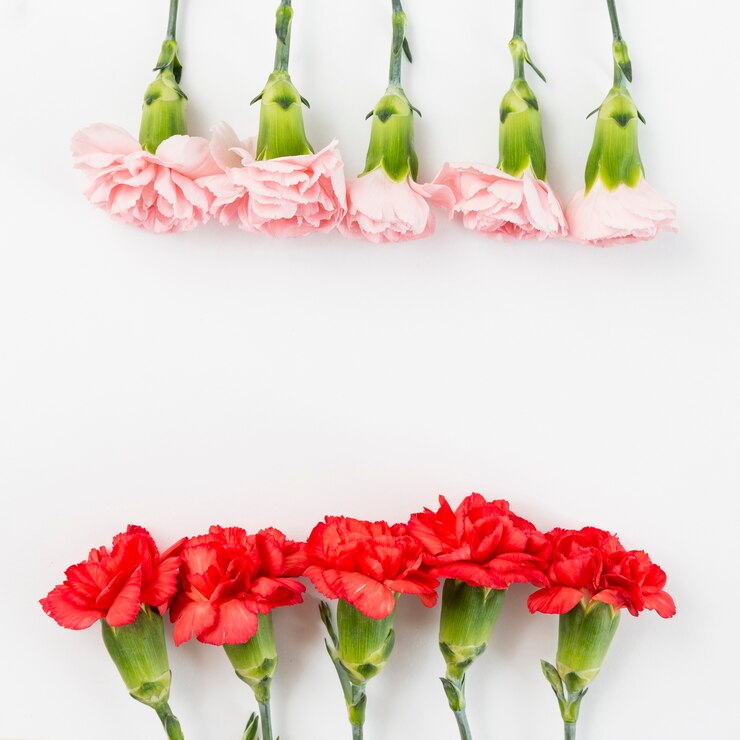As the frosty embrace of winter sets in, January ushers in not just a new year but also a fresh bloom of flowers to celebrate those born in this chilly month.
Join us as we unravel the enchanting tale of January's birth flowers, the Carnation and the Snowdrop, blossoms that add warmth and beauty to the winter landscape.
Carnation: History and Origins Delving into the Roots
The history of the Carnation is a tapestry woven with threads of love, symbolism, and ancient admiration, tracing its roots back to the earliest civilizations.
This enchanting bloom, gracing January as its primary birth flower, has carved a fascinating path through time.
A Stroll Through Antiquity
The Carnation's journey begins in ancient Greece and Rome, where it garnered admiration for its captivating beauty and unique fragrance.
The word "Dianthus," the scientific name for Carnations, originates in Greek mythology.
It combines "dios," meaning gods, and "anthos," meaning flower, signifying the divine nature attributed to these blooms.
The Greeks, in particular, associated the flower with the love of the gods. Which makes it a staple in ceremonial crowns and garlands. 
Crowning Achievements
The Romans, too, embraced the Carnation as a symbol of love and affection. The flower found its place in various aspects of Roman life, from art to celebrations.
It became customary to adorn important events and altars with Carnations, solidifying its role as a token of love and fascination.
Medieval Reverence
As we traverse through history, the Carnation's presence becomes even more pronounced during the Middle Ages. During this time its popularity soared, and it became a symbol of deep passion and love.
The flower was often used in religious ceremonies, where its fragrant petals were believed to carry divine blessings.
Carnation's Name and Lore
The name "Carnation" is believed to have originated from the Latin word "corone," meaning flower garland or coronation.
This further emphasizes the flower's historical association with ceremonial crowns.
Another interpretation links the name to the word "incarnation," drawing a connection between the Carnation's beauty and the divine.
Victorian Sentiments
In the Victorian era, the language of flowers, or floriography, gained popularity as a form of communication.
Carnations played a significant role in this silent dialogue, with each color conveying a distinct message.
Red Carnations, for instance, symbolized deep love and admiration, while white Carnations represented purity and luck.
Carnation in Contemporary Celebrations
Today, the Carnation continues to be a beloved flower. It’s cherished for its rich history and versatile nature.
As the primary birth flower for January, it holds a special place in celebrations, embodying not only the beauty of nature but also the enduring spirit of love.
In the hands of Terra Plants & Flowers, the Carnation's historical significance comes to life in artisanal arrangements that pay homage to its ancient roots.
Each petal tells a story, and every bouquet is a testament to the timeless allure of this extraordinary bloom.
Delve into the roots of the Carnation with Terra Plants & Flowers, where history and beauty converge in a celebration of life and love.
Snowdrop
The Snowdrop, a secondary birth flower for January, emerges as a symbol of hope and purity amid the winter's cold.
These delicate blooms, scientifically named Galanthus, are often associated with the arrival of spring.
Legend has it that they were the first flowers to bloom on the snowy grounds, signifying the triumph of life over winter's grasp.
The Snowdrop's charm lies in its simple yet intricate appearance. With drooping white petals resembling tiny bells, these flowers exude a serene elegance.
Their early blooming nature adds a touch of anticipation and renewal to the winter landscape, making them a perfect emblem for January birthdays.
FAQ - Answered
What Is January's Birth Flower?
In January, the Carnation takes center stage as the primary birth flower, known for its historical significance and captivating appearance.
However, the Snowdrop also shares the spotlight as a secondary birth flower, symbolizing hope and renewal.
Does January Have More Than One Birth Flower?
Indeed, January boasts two birth flowers.
While the Carnation is the primary bloom, the delicate Snowdrop accompanies it, creating a unique duo that encapsulates the essence of January birthdays.
What Is The Flower For Capricorn?
The Carnation holds special significance for those born under the Capricorn zodiac sign.
This vibrant flower aligns with Capricorns' determined and ambitious nature, symbolizing love, loyalty, and admiration.
What Is The Color Of January's Birth Flower?
The primary birth flower, Carnation, comes in various hues, but the red Carnation takes the spotlight for January.
Red symbolizes deep love, admiration, and affection, making it the perfect choice for celebrating January birthdays.
Celebrate January with Elegance
Terra Plants & Flowers invites you to embrace the beauty of January's birth flowers, the Carnation and the Snowdrop.
Whether you're selecting a thoughtful bouquet for a loved one or adorning your space with these symbolic blooms, let the warmth and charm of these flowers create lasting memories.
Celebrate January birthdays with the exquisite artistry of Terra Plants & Flowers, where every petal tells a story of love, hope, and renewal.
